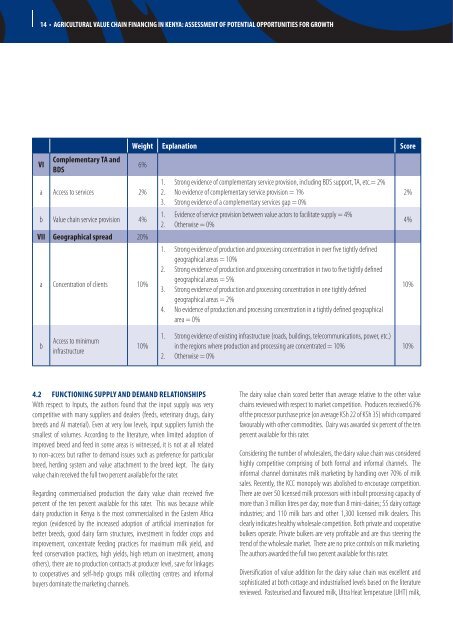AGRICULTURAL VALUe ChAIn FInAnCInG In KenYA
AGRICULTURAL VALUe ChAIn FInAnCInG In KenYA
AGRICULTURAL VALUe ChAIn FInAnCInG In KenYA
Create successful ePaper yourself
Turn your PDF publications into a flip-book with our unique Google optimized e-Paper software.
14 • <strong>AGRICULTURAL</strong> VALUE CHAIN FINANCING IN KENYA: ASSESSMENT OF POTENTIAL OPPORTUNITIES FOR GROWTH<br />
VI<br />
Complementary Ta and<br />
BDS<br />
Weight Explanation Score<br />
6%<br />
a Access to services 2%<br />
b Value chain service provision 4%<br />
VII Geographical spread 20%<br />
a Concentration of clients 10%<br />
b<br />
Access to minimum<br />
infrastructure<br />
10%<br />
4.2 FUNCTIONING SUPPLY aND DEMaND RELaTIONSHIPS<br />
With respect to <strong>In</strong>puts, the authors found that the input supply was very<br />
competitive with many suppliers and dealers (feeds, veterinary drugs, dairy<br />
breeds and AI material). Even at very low levels, input suppliers furnish the<br />
smallest of volumes. According to the literature, when limited adoption of<br />
improved breed and feed in some areas is witnessed, it is not at all related<br />
to non-access but rather to demand issues such as preference for particular<br />
breed, herding system and value attachment to the breed kept. The dairy<br />
value chain received the full two percent available for the rater.<br />
Regarding commercialised production the dairy value chain received five<br />
percent of the ten percent available for this rater. This was because while<br />
dairy production in Kenya is the most commercialised in the Eastern Africa<br />
region (evidenced by the increased adoption of artificial insemination for<br />
better breeds, good dairy farm structures, investment in fodder crops and<br />
improvement, concentrate feeding practices for maximum milk yield, and<br />
feed conservation practices, high yields, high return on investment, among<br />
others), there are no production contracts at producer level, save for linkages<br />
to cooperatives and self-help groups milk collecting centres and informal<br />
buyers dominate the marketing channels.<br />
1.<br />
2.<br />
3.<br />
1.<br />
2.<br />
1.<br />
2.<br />
3.<br />
4.<br />
1.<br />
2.<br />
Strong evidence of complementary service provision, including BDS support, TA, etc.= 2%<br />
No evidence of complementary service provision = 1%<br />
Strong evidence of a complementary services gap = 0%<br />
Evidence of service provision between value actors to facilitate supply = 4%<br />
Otherwise = 0%<br />
Strong evidence of production and processing concentration in over five tightly defined<br />
geographical areas = 10%<br />
Strong evidence of production and processing concentration in two to five tightly defined<br />
geographical areas = 5%<br />
Strong evidence of production and processing concentration in one tightly defined<br />
geographical areas = 2%<br />
No evidence of production and processing concentration in a tightly defined geographical<br />
area = 0%<br />
Strong evidence of existing infrastructure (roads, buildings, telecommunications, power, etc.)<br />
in the regions where production and processing are concentrated = 10%<br />
Otherwise = 0%<br />
2%<br />
4%<br />
10%<br />
10%<br />
The dairy value chain scored better than average relative to the other value<br />
chains reviewed with respect to market competition. Producers received 63%<br />
of the processor purchase price (on average KSh 22 of KSh 35) which compared<br />
favourably with other commodities. Dairy was awarded six percent of the ten<br />
percent available for this rater.<br />
Considering the number of wholesalers, the dairy value chain was considered<br />
highly competitive comprising of both formal and informal channels. The<br />
informal channel dominates milk marketing by handling over 70% of milk<br />
sales. Recently, the KCC monopoly was abolished to encourage competition.<br />
There are over 50 licensed milk processors with inbuilt processing capacity of<br />
more than 3 million litres per day; more than 8 mini-dairies; 55 dairy cottage<br />
industries; and 110 milk bars and other 1,300 licensed milk dealers. This<br />
clearly indicates healthy wholesale competition. Both private and cooperative<br />
bulkers operate. Private bulkers are very profitable and are thus steering the<br />
trend of the wholesale market. There are no price controls on milk marketing.<br />
The authors awarded the full two percent available for this rater.<br />
Diversification of value addition for the dairy value chain was excellent and<br />
sophisticated at both cottage and industrialised levels based on the literature<br />
reviewed. Pasteurised and flavoured milk, Ultra Heat Temperature (UHT) milk,
















